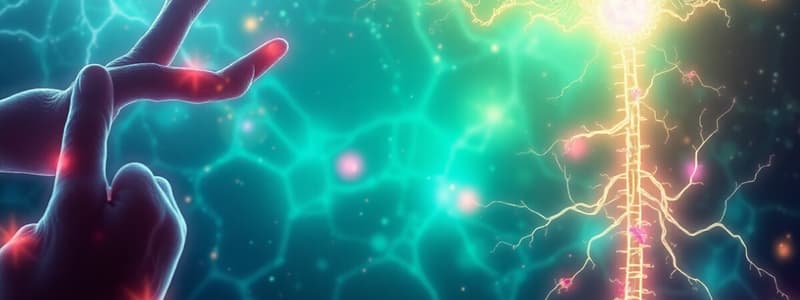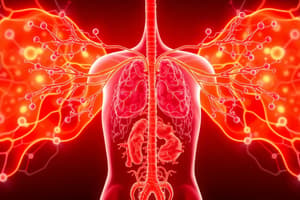Podcast
Questions and Answers
Which of the following hormones is NOT derived from an amino acid?
Which of the following hormones is NOT derived from an amino acid?
- T3
- Cortisol (correct)
- Insulin
- Epinephrine
Which type of hormone signaling involves a hormone acting on the same cell type that released it?
Which type of hormone signaling involves a hormone acting on the same cell type that released it?
- Endocrine
- Intracrine
- Autocrine (correct)
- Paracrine
Hormones like epinephrine and norepinephrine act quickly because they:
Hormones like epinephrine and norepinephrine act quickly because they:
- Are produced by the pituitary gland.
- Are derived from steroids.
- Bind to intracellular receptors.
- Bind to cell surface receptors. (correct)
Which of the following hormones is primarily responsible for regulating blood calcium levels?
Which of the following hormones is primarily responsible for regulating blood calcium levels?
Which of the following glands secretes hormones that regulate both metabolism and reproduction?
Which of the following glands secretes hormones that regulate both metabolism and reproduction?
Which of the following is an example of a hormone that acts on distant sites?
Which of the following is an example of a hormone that acts on distant sites?
Which of the following hormones is produced by the hypothalamus?
Which of the following hormones is produced by the hypothalamus?
Which type of hormone signaling involves a hormone influencing other cells within the same organ or tissue?
Which type of hormone signaling involves a hormone influencing other cells within the same organ or tissue?
Which hormone is NOT released from the anterior pituitary gland?
Which hormone is NOT released from the anterior pituitary gland?
What is the primary mechanism by which hydrophilic hormones exert their effects?
What is the primary mechanism by which hydrophilic hormones exert their effects?
Which of the following is a characteristic of lipophilic hormones, but NOT hydrophilic hormones?
Which of the following is a characteristic of lipophilic hormones, but NOT hydrophilic hormones?
Which hormone uses an enzyme-linked receptor with alpha and beta subunits for its signal transduction?
Which hormone uses an enzyme-linked receptor with alpha and beta subunits for its signal transduction?
Why is the free form of a hormone the only form that can regulate biological processes?
Why is the free form of a hormone the only form that can regulate biological processes?
Which of the following statements accurately describes the mechanism of action of steroid hormones?
Which of the following statements accurately describes the mechanism of action of steroid hormones?
Which hormone is involved in regulating blood sugar levels?
Which hormone is involved in regulating blood sugar levels?
Which of the following binding proteins carries thyroid hormones (T3 and T4) in the blood?
Which of the following binding proteins carries thyroid hormones (T3 and T4) in the blood?
What is the primary role of the hypothalamus in hormone regulation?
What is the primary role of the hypothalamus in hormone regulation?
Which hormone is primarily responsible for regulating Na+ and K+ balance in the body?
Which hormone is primarily responsible for regulating Na+ and K+ balance in the body?
Flashcards
Endocrine System
Endocrine System
Regulates biological processes via hormones, ensuring communication among organs.
Hormone Action Speed
Hormone Action Speed
Hormones can act quickly (seconds) or slowly (days), affecting various processes.
Homeostasis
Homeostasis
The body's state of stable internal conditions, like temperature and blood pressure.
Hormone types by signaling
Hormone types by signaling
Signup and view all the flashcards
Amino Acid Derived Hormones
Amino Acid Derived Hormones
Signup and view all the flashcards
Protein and Peptide Hormones
Protein and Peptide Hormones
Signup and view all the flashcards
Hypothalamus Hormones
Hypothalamus Hormones
Signup and view all the flashcards
Adrenal Gland Hormones
Adrenal Gland Hormones
Signup and view all the flashcards
Hypothalamus
Hypothalamus
Signup and view all the flashcards
Anterior Pituitary
Anterior Pituitary
Signup and view all the flashcards
Hydrophilic Hormones
Hydrophilic Hormones
Signup and view all the flashcards
Lipophilic Hormones
Lipophilic Hormones
Signup and view all the flashcards
Binding Proteins
Binding Proteins
Signup and view all the flashcards
Steroid Hormones
Steroid Hormones
Signup and view all the flashcards
Signal Transduction
Signal Transduction
Signup and view all the flashcards
Free Hormone
Free Hormone
Signup and view all the flashcards
Genomic Effect
Genomic Effect
Signup and view all the flashcards
G Protein-Coupled Receptors (GPCR)
G Protein-Coupled Receptors (GPCR)
Signup and view all the flashcards
Study Notes
Endocrine System Overview
- The endocrine system regulates and coordinates biological processes within the body.
- It allows communication between organs, tissues, and cells, both locally and distantly.
- Crucial for maintaining homeostasis, including temperature and blood pressure.
- Involved in regulating reproduction.
- Hormone action speed varies, ranging from seconds to days.
- Fast-acting hormones (e.g., epinephrine, norepinephrine) respond rapidly to events like shock.
- Slow-acting hormones (e.g., steroid hormones) have a slower response due to their specific mechanisms.
- Endocrine dysfunction can disrupt key biological processes like reproduction, growth, metabolism, and homeostasis.
Endocrine Glands and Hormones
- Hypothalamus: Releases GHRH, CRH, TRH, GNRH, somatostatin, dopamine, vasopressin, oxytocin.
- Pituitary Gland: Secretes growth hormone, prolactin, ACTH, and other hormones.
- Parathyroid Gland: Produces parathyroid hormone (PTH).
- Pancreas: Secretes insulin, glucagon, and somatostatin.
- Testes: Produce testosterone.
- Ovaries: Release estrogen and progesterone.
- Adrenal Gland: Synthesizes cortisol, aldosterone, androgens, epinephrine, and norepinephrine.
- Thyroid Gland: Produces T4 and T3 (T3 is more potent).
- Adipose Tissue: Releases leptin, adiponectin, and resistin.
- GI Tract: Secretes secretin, gastrin, CCK, motilin, and other hormones.
- Bones: Produce FGF 23.
Hormone Signaling
- Endocrine: Hormones released into the bloodstream act on distant target tissues (e.g., insulin and glucagon).
- Paracrine: Hormones act on nearby cells within the same tissue (e.g., estrogen in the ovaries).
- Autocrine: Hormones act on the same cell that secreted them.
- Intracrine: Hormone action occurs within the same cell without release.
Hormone Chemistry
- Amino Acid-Derived Hormones: Made from amino acids; examples include T3, T4, calcitonin, catecholamines, dopamine.
- Protein/Peptide Hormones: Larger than amino acid-derived hormones, examples include hormones from hypothalamus, anterior and posterior pituitary, pancreas, parathyroid gland, adipose tissue and the GI tract.
- Steroid Hormones: Lipid-soluble, derived from cholesterol; examples are cortisol, aldosterone, androgens, estrogen, testosterone, progesterone, and Vitamin D.
Hypothalamus and Pituitary
- The hypothalamus is situated at the top of the brain.
- The pituitary gland, located below the hypothalamus, has two sections:
- The anterior pituitary secretes a wide range of hormones.
- The posterior pituitary secretes vasopressin and oxytocin.
Hydrophilic vs. Lipophilic Hormones
| Feature | Hydrophilic Hormones | Lipophilic Hormones |
|---|---|---|
| Water/Lipid Affinity | Water-loving | Lipid-loving |
| Chemical Derivation | Amino acids, peptides, proteins | Steroids |
| Storage | Yes (in secretory granules) | Little to no storage |
| Half-life | Short | Long |
| Blood Transport | Mainly unbound or loosely bound | Primarily bound to blood proteins |
| Receptor Location | Cell membrane receptors | Intracellular receptors |
| Cellular Response | Relatively fast, often short-lived, non-genomic | Slower, predominantly genomic |
| Oral Administration | Usually inactivated | Often given orally |
| Brain Access | Limited access (e.g., circumventricular organs) | Can cross blood-brain barrier readily, with some limitations |
Hormone Transportation and Binding Proteins
- Hormones often bind to proteins in the blood.
- Binding proteins include TBG, transthyretin, CBG, SHBG, DBG, albumin.
- Only free hormones can elicit cellular responses.
Mechanism of Action
- Protein/Peptide Hormones: Cannot pass cell membranes directly; bind to cell-surface receptors, triggering intracellular signaling cascades.
- Insulin uses receptor tyrosine kinases.
- LH, ACTH, and epinephrine use G protein-coupled receptors.
- Steroid Hormones: Lipid-soluble; diffuse across cell membranes and bind to intracellular receptors that regulate gene expression (slower action, longer effect).
Studying That Suits You
Use AI to generate personalized quizzes and flashcards to suit your learning preferences.




